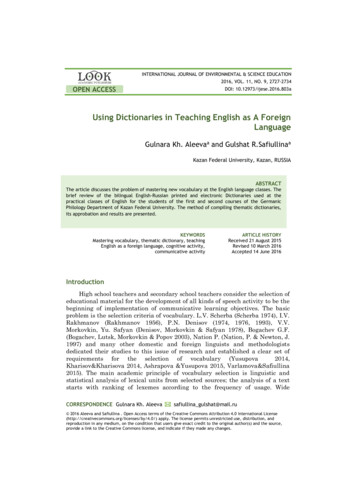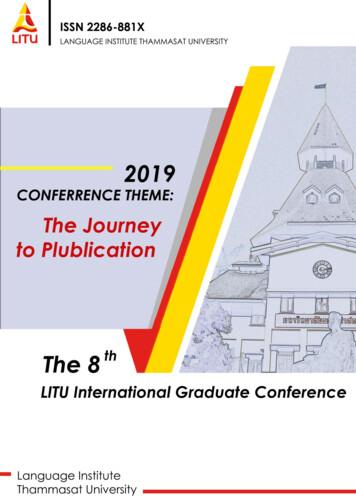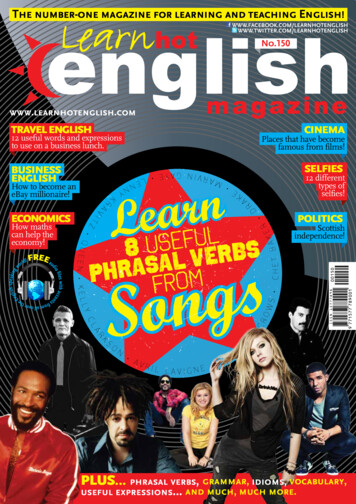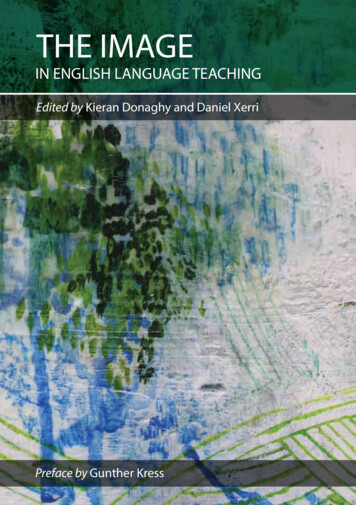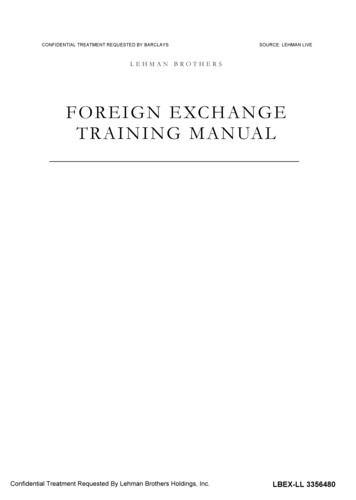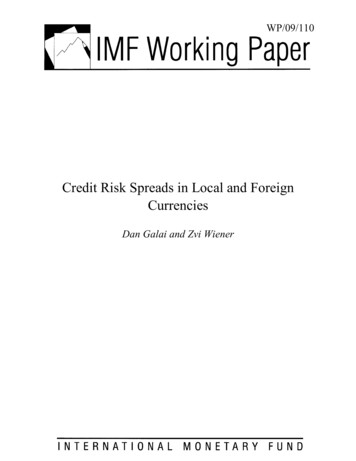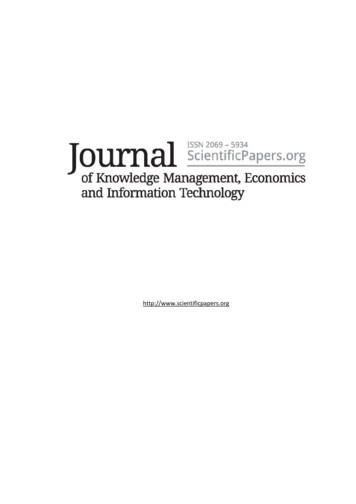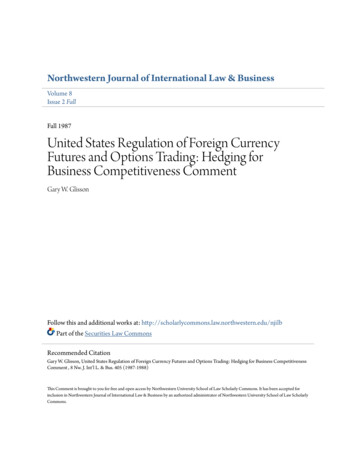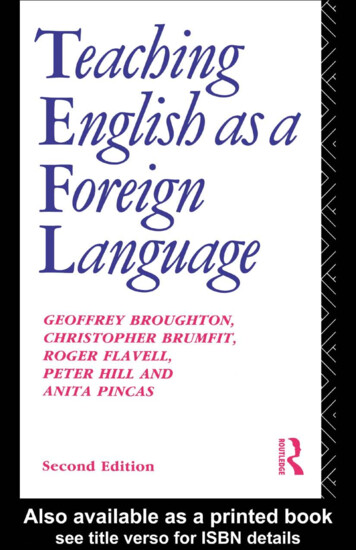
Transcription
Teaching Englishas a Foreign Language
Routledge Education BooksAdvisory editor: John EgglestonProfessor of EducationUniversity of Warwick
Teaching Englishas a Foreign LanguageSecond EditionGeoffrey Broughton,Christopher Brumfit,Roger Flavell,Peter Hill and Anita PincasUniversity of London Institute of EducationLondon and New York
First published 1978 by Routledge & Kegan Paul LtdThis edition published in the Taylor & Francis e-Library, 2003.Second edition published 1980Simultaneously published in the USA and Canadaby Routledge29 West 35th Street, New York, NY 10001 1978, 1980 Geoffrey Broughton, Christopher Brumfit, RogerFlavell, Peter Hill and Anita PincasAll rights reserved. No part of this book may be reprinted orreproduced or utlized in any form or by any electronic,mechanical, or other means, now known or hereafter invented,including photocopying and recording, or in any informationstorage or retrieval system, without permission in writing fromthe publishers.British Library Cataloguing in Publication DataTeaching English as a foreign language—(Routledgeeducation books).1. English Language—Study and teaching—Foreign studentsI. Broughton, Geoffrey428’ .2’ 407 PE1128.A2 78–40161ISBN 0-203-41254-0 Master e-book ISBNISBN 0-203-72078-4 (Adobe eReader Format)ISBN 0-415-05882-1 (Print Edition)
ContentsPreface1234567891011121314viiEnglish in the World TodayIn the ClassroomLanguage and CommunicationBasic PrinciplesPronunciationListening and SpeakingReadingWritingErrors, Correction and Remedial WorkAssessment and ExaminationsYoung Children Learning EnglishLearning English in the Secondary SchoolTeaching English to AdultsThe English ix 1Appendix 2Glossary of Selected TermsBibliographyUseful PeriodicalsIndex211212214233240241v
PrefaceThe increased learning and teaching of English throughout theworld during recent years in both state and commercialeducational institutions has produced a new cadre ofprofessionals: teachers of EFL. Some have moved across fromteaching English as a mother tongue, others from teachingmodern languages; many have been drawn into service for noother reason than that their own spoken English is good, orperhaps because they are native English speakers. Many havestarted without specific training, others feel they need torethink the basis of their teaching.This book is written for teachers of all backgrounds. Ouraim is to discuss a wide range of teaching problems—fromclassroom techniques to school organisation—in order tohelp practising teachers in their daily tasks. We have adoptedan eclectic approach, recognising that the teaching of Englishmust be principled without being dogmatic, and systematicwithout being inflexible. We have tried to show how theunderlying principles of successful foreign language teachingcan provide teachers in a wide range of EFL situations with abasic level of competence which can be a springboard fortheir subsequent professional development. We gratefullyrecord our debt to colleagues and students past and presentat the London University Institute of Education, whoseexperience and thinking have helped shape our own.Particularly, we would like to thank our colleague JohnNorrish for compiling the bibliography.vii
Chapter 1English in the WorldTodayEnglish as an international languageOf the 4,000 to 5,000 living languages, English is by far themost widely used. As a mother tongue, it ranks second onlyto Chinese, which is effectively six mutually unintelligibledialects little used outside China. On the other hand the 300million native speakers of English are to be found in everycontinent, and an equally widely distributed body of secondlanguage speakers, who use English for their day-to-dayneeds, totals over 250 million. Finally, if we add those areaswhere decisions affecting life and welfare are made andannounced in English, we cover one-sixth of the world’spopulation.Barriers of race, colour and creed are no hindrance to thecontinuing spread of the use of English. Besides being a majorvehicle of debate at the United Nations, and the language ofcommand for NATO, it is the official language ofinternational aviation, and unofficially is the first language ofinternational sport and the pop scene. Russian propaganda tothe Far East is broadcast in English, as are Chinese radioprogrammes designed to win friends among listeners in EastAfrica. Indeed more than 60 per cent of the world’s radioprogrammes are broadcast in English and it is also thelanguage of 70 per cent of the world’s mail. From its position400 years ago as a dialect, little known beyond the southerncounties of England, English has grown to its present status asthe major world language. The primary growth in the number1
English in the World Todayof native speakers was due to population increases in thenineteenth century in Britain and the USA. The figures for theUK rose from 9 million in 1800 to 30 million in 1900, to some56 million today. Even more striking was the increase in theUSA (largely due to immigration) from 4 million in 1800, to76 million a century later and an estimated 216, 451, 900today. Additionally the development of British colonies tooklarge numbers of English-speaking settlers to Canada, severalAfrican territories and Australasia.It was, however, the introduction of English to theindigenous peoples of British colonies which led to theexistence today of numerous independent states where Englishcontinues in daily use. The instrument of colonial power, themedium for commerce and education, English became thecommon means of communication: what is more, it was seenas a vehicle for benevolent Victorian enlightenment. Thelanguage policy in British India and other territories waslargely the fruit of Lord Macaulay’s Education Minute of1835, wherein he sought toform a class who may be interpreters between us and themillions we govern—a class of persons Indian in bloodand colour, but English in tastes, in opinions, in moralsand in intellect.Although no one today would defend the teaching of alanguage to produce a cadre of honorary Englishmen, the useof English throughout the sub-continent with its 845 distinctlanguages and dialects was clearly necessary for administrative purposes.The subsequent role of English in India has beensignificant. In 1950, the Central Government decided thatthe official language would be Hindi and the transition fromEnglish was to be complete by 1965. The ensuingprotestations that English was a unifying power in the newlyindependent nation, a language used by the administration,judiciary, legislators and the press for over a century, wereaccompanied by bloody riots. Mr Nehru acknowledged inparliament that English was ‘the major window for us to theoutside world. We dare not close that window, and if we do itwill spell peril for the future!’ When in 1965 Hindi was2
English in the World Todayproclaimed the sole official language, the Shastri governmentwasseverely shaken by the resulting demonstrations. Onlyafter students had burnt themselves to death and a hundredrioters had been shot by police was it agreed that Englishshould continue as an associate official language.The 65 million speakers of Hindi were a strong argumentfor selecting it as India’s national language. But a number ofnewly independent nations have no one widely spokenlanguage which can be used for building national unity. InWest Africa (there are 400 different languages in Nigeriaalone) English or French are often the only commonlanguages available once a speaker has left his own area.English is accordingly the official language of both Ghanaand Nigeria, used in every walk of daily life. Indeed, Englishhas become a significant factor in national unity in a broadband of nations from Sierra Leone to Malaysia. It is thenational language of twenty-nine countries (USA andAustralia, of course, but also Lesotho and Liberia) and it isalso an official language in fifteen others: South Africa andCanada, predictably, but also Cameroon and Dahomey.There is, however, a further reason why English enjoysworld-wide currency, apart from political and historicalconsiderations. The rapidly developing technology of theEnglishspeaking countries has made British and Americantelevision and radio programmes, films, recordings and booksreadily available in all but the most undeveloped countries.Half the world’s scientific literature is written in English. Bycomparison, languages like Arabic, Yoruba and Malay havebeen little equipped to handle the concepts and terms ofmodern sciences and technology. English is therefore often theonly available tool for twentieth-century learning.When Voltaire said The first among languages is thatwhich possesses the largest number of excellent works’, hecould not have been thinking of publications of the MITPress, cassette recordings of English pop groups or theworldwide successes of BBC television enterprises. But it ispartly through agencies as varied and modern as these thatthe demand for English is made and met, and by which itsunique position in the world is sustained.3
English in the World TodayEnglish as a first language and second languageIt is arguable that native speakers of English can no longermake strong proprietary claims to the language which theynow share with most of the developed world. The CairoEgyptian Gazette declared ‘English is not the property ofcapitalist Americans, but of all the world’, and perhaps theassertion may be made even more convincingly in Singapore,Kampala, and Manila. Bereft of former overtones of politicaldomination, English now exists in its own right in a numberof world varieties. Unlike French, which continues to bebased upon one metropolitan culture, the English languagehas taken on a number of regional forms. What Englishmancan deny that a form of English, closely related to his own—equally communicative, equally worthy of respect—is usedin San Francisco, Auckland, Hong Kong and New Delhi?And has the Mid-West lady visitor to London any more rightto crow with delight, ‘But you speak our language—youspeak English just like we do’, than someone from Sydney,Accra, Valletta, or Port-of-Spain, Trinidad?It may be argued, then, that a number of world varieties ofEnglish exist: British, American, Caribbean, West African,East African, Indian, South-east Asian, Australasian amongothers; having distinctive aspects of pronunciation and usage,by which they are recognised, whilst being mutuallyintelligible. (It needs hardly be pointed out that within thesebroad varieties there are dialects: the differences between thelocal speech of Exeter and Newcastle, of Boston and Dallas, ofNassau and Tobago are on the one hand sufficiently differentto be recognised by speakers of other varieties, yet on the otherto be acknowledged as dialects of the same variety.)Of these geographically disparate varieties of English thereare two kinds: those of first language situations whereEnglish is the mother tongue (MT), as in the USA orAustralasia, and second language (SL) situations, whereEnglish is the language of commercial, administrative andeducational institutions, as in Ghana or Singapore.Each variety of English marks a speech community, and inmotivational terms learners of English may wish to feelthemselves members of a particular speech community andidentify a target variety accordingly. In several cases, thereis4
English in the World Todaylittle consciousness of choice of target. For example theGreek Cypriot immigrant in London, the new Australianfrom Italy and the Puerto Rican in New York will have selfselecting targets. In second language situations, the localvariety will be the goal. That is, the Fulani learner will learnthe educated West African variety of English, not British,American or Indian. This may appear self-evident, yet insome areas the choice of target variety is hotly contested.For example, what kind of English should be taught inSingapore schools to the largely Chinese population? Oneview is that of the British businessman who argues that hislocal employees are using English daily, not only with him, butin commercial contacts with other countries and Britain.Therefore they must write their letters and speak on thetelephone in a universally understood form of English. This isthe argument for teaching British Received Pronunciation(RP), which Daniel Jones defined as that ‘most usually heardin the families of Southern English people who have beeneducated at the public schools’, and for teaching the grammarand vocabulary which mark the standard British variety. Theopposite view, often taken by Singaporean speakers ofEnglish, is that in using English they are not trying to beEnglishmen or to identify with RP speakers. They are Chinesespeakers of English in a community which has a distinctiveform of the language. By speaking a South-east Asian varietyof English, they are wearing a South-East linguistic badge,which is far more appropriate than a British one.The above attitudes reflect the two main kinds ofmotivation in foreign language learning: instrumental andintegrative. When anyone learns a foreign languageinstrumentally, he needs it for operational purposes—to beable to read books in the new language, to be able tocommunicate with other speakers of that language. Thetourist, the salesman, the science student are clearlymotivated to learn English instrumentally. When anyonelearns a foreign language for integrative purposes, he istrying to identify much more closely with a speechcommunity which uses that language variety; he wants to feelat home in it, he tries to understand the attitudes and theworld view of that community. The immigrant in Britain andthe second language speaker of English, though gaining5
English in the World Todaymastery of different varieties ofEnglish, are both learningEnglish for integrative purposes.In a second language situation, English is the language ofthe mass med
12 Learning English in the Secondary School 174 13 Teaching English to Adults 187 14 The English Department 201 Appendix 1 211 Appendix 2 212 Glossary of Selected Terms 214 Bibliography 233 Useful Periodicals 240 Index 241. vii Preface The increased learning and teaching of English throughout the world during recent years in both state and commercial educational institutions has

